Related Research Articles

Saturniidae, members of which are commonly named the saturniids, is a family of Lepidoptera with an estimated 2,300 described species. The family contains some of the largest species of moths in the world. Notable members include the emperor moths, royal moths, and giant silk moths.

Bombycoidea is a superfamily of moths, including the silk moths, giant silk moths, sphinx moths, saturniids, and relatives. The superfamily Lasiocampoidea is a close relative and was historically sometimes merged in this group. After many years of debate and shifting taxonomies, the most recent classifications treat the superfamily as containing 10 constituent families.
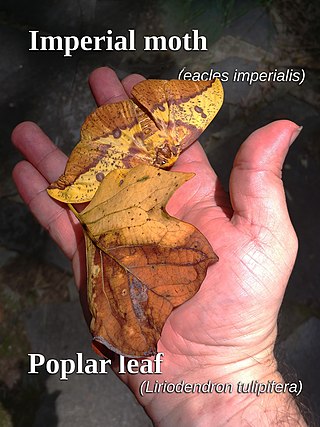
Eacles is a genus of moths in the family Saturniidae. They are native to the Americas. The genus was erected by Jacob Hübner in 1819.

The dryandra moth is a species of moth that is considered to be the sole member of the family Carthaeidae. Its closest relatives are the Saturniidae and it bears a resemblance to many species of that family, bearing prominent eyespots on all wings. The common name is derived from the Dryandra shrubs of the genus Banksia, on which the larva of this species feed, and is hence restricted to the south-west of Western Australia where these shrubs grow. Other Grevillea shrubs may also be used as host plants.

Caligula is a genus of moths of the family Saturniidae. It is primarily an Oriental genus, found in India, China and Southeast Asia. The genus is often treated as a synonym of Rinaca. It is named after Roman emperor Caligula.

The Saturniinae or saturniines are a subfamily of the family Saturniidae, also known as giant silkmoths. They are commonly known as emperor moths or wild silk moths. They are easily spotted by the eyespots on the upper surface of their wings. Some exhibit realistic eye-like markings, whilst others have adapted the eyespots to form crescent moon or angular shapes or have lost their wing scales to create transparent windows. They are medium to very large moths, with adult wingspans ranging from 7.5 to 15 cm, in some cases even more. They consist of some of the largest sized Lepidoptera, such as the luna moth, atlas moth, and many more. The Saturniinae is an important source of wild silk and human food in many different cultures.
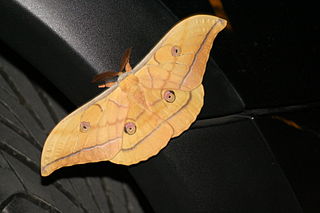
Antheraea yamamai, the Japanese silk moth or Japanese oak silkmoth is a moth of the family Saturniidae. It is endemic to east Asia, but has been imported to Europe for tussar silk production and is now found in southeastern Europe, mainly in Austria, northeastern Italy, and the Balkans. It seems to be spreading north and a population has been reported near Deggendorf and Passau in Germany. The species was first described by Félix Édouard Guérin-Méneville in 1861. It has been hybridized artificially with Antheraea polyphemus of North America.
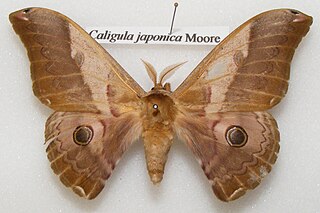
Caligula japonica, the Japanese giant silkworm, is a moth of the family Saturniidae. It was described by Frederic Moore in 1872. It is found in eastern Asia, including China, Korea, Japan and Russia.
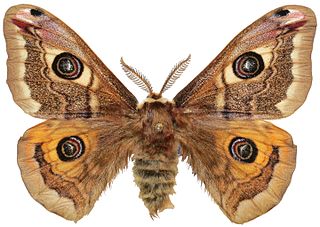
Saturnia pavoniella is a moth of the family Saturniidae. It is found in the alpine regions of Austria, Italy and the Czech Republic across south-eastern Europe to northern Turkey and the Caucasus. It is possibly also present in south-eastern France.

Antherina is a monotypic moth genus in the family Saturniidae erected by William Elford Leach in 1815. Its only species, Antherina suraka, the Suraka silk moth, was first described by Jean Baptiste Boisduval in 1833. It is found on Madagascar and Mayotte. Both larvae and pupae consumed in parts of Madagascar, but not to a great extent. The larvae feed on oleander, privet, willows, beech, Liquidambar, Crataegus (hawthorns), grapevine, lilac, cherry, laurel, Forsythia, Rhus, Pistacia, apple, pear, plum and peach leaves, but foodplants differ from species to species. They start off black with yellow protrusions to eventually green with red and yellow on their bodies. Once they've finished growing they will be as thick as your finger and when they have reached their final days as a caterpillar they will develop a blue dorsal stripe and wander around looking for a place to pupate.

Perisomena caecigena, the autumn emperor moth, is a moth of the family Saturniidae, first described by Franz Josef Kupido in 1825. It lives in Italy and then from south-eastern Austria through Hungary, Slovenia, Croatia, Serbia, Albania, the western Ukraine, Romania, Bulgaria and Greece to most of Turkey and the Caucasus Mountains of the Republic of Georgia, Armenia and Azerbaijan. There is also an isolated population in the mountains of Lebanon and Israel. Subspecies stroehlei is endemic to the Troodos Mountains of Cyprus.
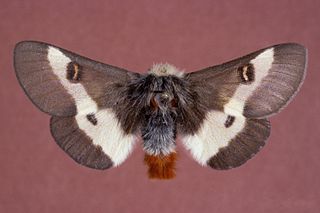
Hemileucinae is a subfamily of the family Saturniidae, including a number of taxa whose caterpillars have venomous urticating hairs.
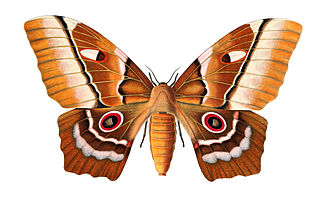
Pseudimbrasia is a monotypic moth genus in the family Saturniidae described by Pierre Claude Rougeot in 1962. Its only species, Pseudimbrasia deyrollei, described by James Thomson in 1858, is found in the mid-latitudes of Africa.
Gilles Terral was a French entomologist. He specialised in Lepidoptera Parnassiinae and Saturniidae.

Automeris is a genus of moths in the family Saturniidae and the subfamily Hemileucinae. As of 1996 there were 124 species, and more have since been described. These moths are generally characterized by the eyelike patches on the hindwings and the leaflike pattern on the forewings, an example of crypsis. The genus was first described by Jacob Hübner in 1819 and it is distributed in the Neotropical realm.
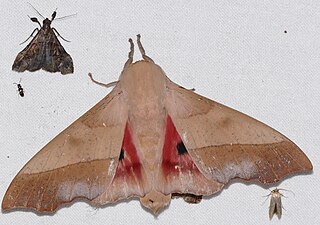
Syssphinx is a genus of moths of the family Saturniidae. The genus was erected by Jacob Hübner in 1819.

Hemileuca is a genus of moths in the family Saturniidae first described by Francis Walker in 1855.

Hyalophora is a genus of moths in the family Saturniidae. The genus was erected by James Duncan and John O. Westwood in 1841.

Samia is a genus of moths in the family Saturniidae. The genus was erected by Jacob Hübner in 1819.
References
- ↑ Rougerie, R. & Collective of iBOL Saturniidae expert taxonomists (2009). "Online list of valid and available names of the Saturniidae of the World". Lepidoptera Barcode of Life: Saturniidae.